Inside Climate News: Industrial Agriculture, an Extraction Industry Like Fossil Fuels, a Growing Driver of Climate Change
by Georgina Gustin | January 25, 2019
Industrial farming encourages practices that degrade the soil and increase emissions, while leaving farmers more vulnerable to damage as the planet warms.
On his farm in southwestern Iowa, Seth Watkins plants several different crops and raises cattle.
He controls erosion and water pollution by leaving some land permanently covered in native grass. He grazes his cattle on pasture, and he sows cover crops to hold the fertile soil in place during the harsh Midwestern winters.
Watkins’ farm is a patchwork of diversity—and his fields mark it as an outlier.
His practices don’t sound radical, but Watkins is a bit of a renegade. He’s among a small contingent of farmers in the region who are holding out against a decades-long trend of consolidation and expansion in American agriculture.
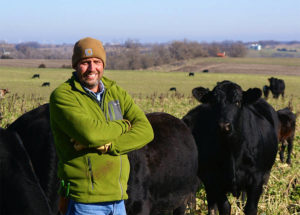
“I can see the impact of the changing climate,” Seth Watkins said. “I know, in the immediate, I’ve got to manage the issue. In the long term, it means doing something to slow down the problem.” Credit: Tatum Watkins
“I can see the impact of the changing climate,” he said. “I know, in the immediate, I’ve got to manage the issue. In the long term, it means doing something to slow down the problem.”
But for several decades, ever-bigger and less-varied farms have overtaken diversified operations like his, replacing them with industrialized row crops or gigantic impoundments of cattle, hogs and chickens.
This trend is a central reason why American agriculture has failed to deal with climate change, a crisis that has been made worse by large-scale farming practices even as it afflicts farmers themselves.
Consolidation has swallowed smaller farms, bolstering a financial and regulatory status quo that has thwarted the kind of climate-friendly approach Watkins and his fellow outliers employ.
“I don’t think any of us wants to get bigger,” Watkins mused. “It’s just the curse of a commodity business. We made all the focus on production, and all the economics, the subsidies, are tied to production. We have a production-focused agriculture policy.”
This article is part of a series by InsideClimate News exploring agriculture’s role in the global warming crisis and the forces preventing it from playing a greater part in combating climate change.
The consolidation of American farming, reinforced by an emphasis on just one or two main crops—corn and soybeans—has led to a system in which there’s little incentive to grow much else, especially in the agricultural heartland of the Midwest.
This has profound climate and environmental implications. Mega-sized farming encourages practices that degrade the soil, waste fertilizer and mishandle manure, all of which directly increase emissions of greenhouse gases. At the same time, it discourages practices like “no-till” farming and crop rotation that grab carbon dioxide from the air, store it in the soil and improve soil health.
“The industrial food system presents a barrier to realizing the potential climate benefits in agriculture,” said Laura Lengnick, a soil scientist who has written extensively on climate and agriculture. “We continue to invest in this massive corn and soybean and beef-making machine in the Midwest despite all that we know about the changes we could make that would maintain yields, improve farm profitability and deliver climate change solutions.”
This is happening as landmark government reports and ample academic research show that agricultural soils are critical for stabilizing the climate.
One recent government report called the trend toward ever-bigger farms “persistent, widespread and pronounced.”
The report, a comprehensive assessment of consolidation published last year by the U.S. Department of Agriculture’s Economic Research Service, confirmed what was already apparent to small farmers: “Agricultural production has shifted to much larger farming operations over the last three decades.”
While the report concluded that consolidation is responsible for improvements in productivity, it noted: “At the same time, large-scale farming operations are said to force small farms out of business, damage the viability of rural communities, reduce the diversity of agricultural production, and create environmental risks through their production practices.”
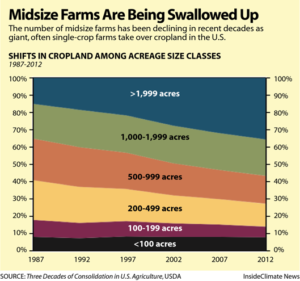 More than a third of cropland is on farms bigger than 2,000 acres. That’s twice the share of land held on big farms 30 years ago.
More than a third of cropland is on farms bigger than 2,000 acres. That’s twice the share of land held on big farms 30 years ago.
Bigger operations are richer, too. Half of the value of farm production came from those with annual sales of at least $1 million.
The drivers behind this ongoing expansion are intertwined and complex—a confluence of politics, economics and technology. Agricultural policy has long emphasized over-production, propped up by government subsidies that favor certain crops. Lawmakers have been unwilling to change the system, largely because of a powerful farm lobby and the might of agribusinesses that profit from technological advancements.
“Farmers are dictated in how to farm,” said Adam Mason, a policy director with Iowa Citizens for Community Improvement. “They’re locked into a system.”
This system has transformed agriculture into a business that resembles the fossil fuel industry as it extracts value out of the ground with relentless efficiency and leaves greenhouse gas pollution in its aftermath.
“From a climate, soil health, and carbon sequestering perspective, we need greater diversity,” said Ferd Hoefner of the National Sustainable Agriculture Coalition. “We’re never going to make huge progress on soil health and carbon sequestration until we get that diversity.”
Subsidized Corn and Beans
“You come down to Iowa, it’s all corn and beans, and it’s neutering the land,” said Chris Peterson at his family’s farm near Clear Lake. The farm was nearly pushed out of business in the 1990s, Peterson said, because of consolidation in the livestock industry, but he managed to hang on by finding niche markets for the pork he produces.
Four or five decades ago, typical American farms looked a lot more like Peterson’s, growing several crops and raising livestock in diversified, integrated and time-honored synchrony. Farmers sold some crops and fed others to their animals, which also foraged on grass and over-wintered on hay. Cash crops paid the bills and meat met the mortgage.
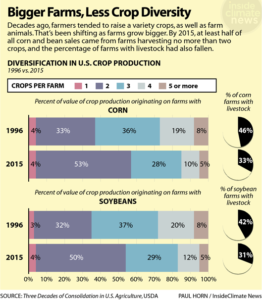 Hefty government subsidies, along with market forces and technology, have since tilted the balance to corn and soybeans, transforming much of the Midwest into a vast duoculture of those two crops. The fields get bigger and bigger.
Hefty government subsidies, along with market forces and technology, have since tilted the balance to corn and soybeans, transforming much of the Midwest into a vast duoculture of those two crops. The fields get bigger and bigger.
“Subsidies give the larger producers the resources to add more ground that they can tack on to their ever-growing acreage,” Hoefner said. “We directly subsidize consolidation. We reduced the risk of consolidation. Without subsidies, crop insurance and commodity payments, consolidation would have gone much more slowly.”
The resulting corn-and-beans duo demands the heavy use of fertilizers—especially nitrogen synthesized from natural gas—and depletes the soils. And by neglecting diversity, the system forfeits a crucial recovery cycle that would build soil back up and improve its ability to hold carbon.
“We could do a lot to change this simply by shifting to policies that promote nature-based climate resilience,” Lengnick said.
Farm to Fuel
Like subsidies, government mandates to use biofuels have pushed farmers to expand corn and soybean acreage—especially on environmentally sensitive land.
“A lot of erodible land, and some in wetlands, was converted to row crops,” said Matt Liebman, an agronomy professor at Iowa State University. “If you want to soak up the surplus, putting it into ethanol is a good way to do that.”
The mandates require refineries to blend a percentage of biofuels, including corn-based ethanol or soy-based biodiesel, into their fuel mix. Demand for the two crops shot up, adding pressure to shift land into producing them.
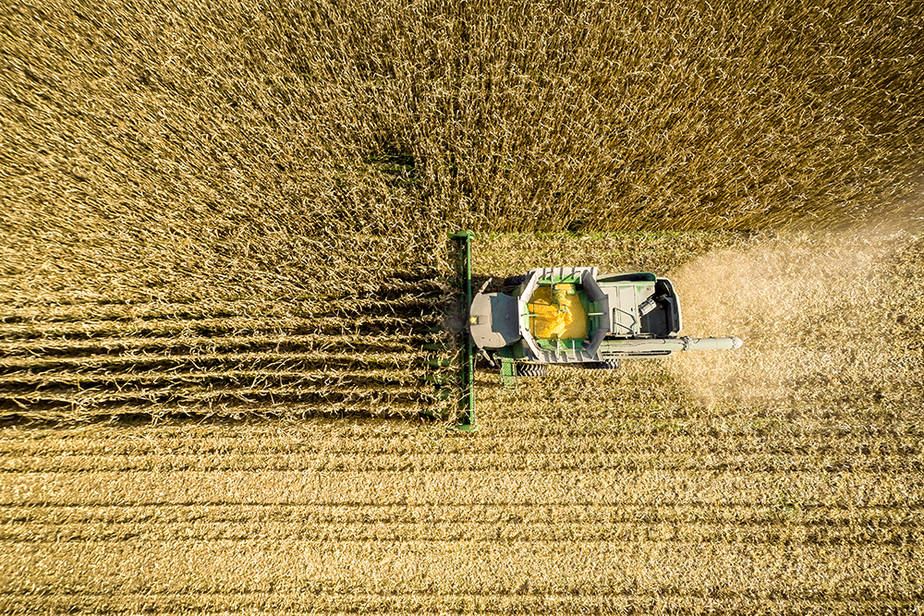
Government biofuel mandates have pushed farmers to grow more corn, including on environmentally sensitive land. Credit: Edwin Remsburg/VW Pics via Getty Images
But just like what’s happened to oil and gas in the fracking boom, ample supply tended to depress prices. Aside from several years of record crop prices, peaking in 2012, profit margins have remained low, so farmers are driven to compensate by boosting volumes.
“If you’re making fewer dollars per acre, you try to farm more acres,” Liebman said.
As ethanol mandates arrived, genetically modified “Roundup Ready” corn and soybeans had become the dominant crops in the country. Engineering these crops to withstand herbicides that kill weeds made them easier to grow across ever-bigger pieces of land.
“Dumb it down, scale it up—that’s what happened,” said Mary Hendrickson, a professor of rural sociology at the University of Missouri, who has studied consolidation in the industry.
Hendrickson said that developments in agricultural technology, including genetically modified crops, have tended to benefit bigger farmers. “You already have consolidation, and farmers who have capital are the ones who benefit,” she said. “The technology is not neutral.”
While genetically modified crops simplified farming, they also boosted herbicide and fertilizer use. The Midwest became a nitrogen fertilizer hotspot, causing soils to emit more nitrous oxide, a potent greenhouse gas. The enriched runoff also feeds algal blooms, another source of greenhouse gases, which recent research suggests are probably undercalculated.
Erosion, loss of grassland, greenhouse gas emissions linked to fertilizers—these, along with methane from manure, are central culprits in agriculture’s expanding climate footprint. The convergence of policy and technology has worsened all of them.
Meat and Mergers
Critics say that lax enforcement of antitrust laws has enabled even more concentration in the hands of fewer companies.
That concentration has occurred not just at the farm level but throughout the food system, including in fertilizer and pesticide manufacturing, grain distribution, food processing and grocery retailing. Four companies or fewer control each of these sectors of the food industry.
Recent mega-mergers of agricultural chemical and seed companies—Monsanto and Bayer, ChinaChem and Syngenta, Dow Chemical and DuPont—have further concentrated seed technology in the hands of a few companies. Critics worry that could leave farmers with fewer choices over what to plant and how.
Nowhere has the consolidation been more pronounced than in the meat industry, a hugely profitable and influential force in American agriculture. Today, a handful of companies, led by Brazil-based JBS Holdings, dominate the global meat industry, wielding enormous economic and political might.
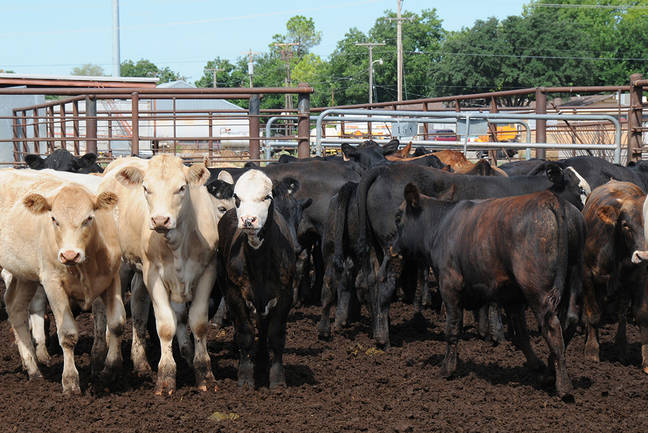
Consolidation has been most pronounced in the meat industry, dominated by a handful of companies that wield enormous political and economic power. Credit: Alice Welch/U.S. Department of Agriculture
“It’s JBS and Smithfield,” said Joe Maxwell, a hog farmer from Missouri and executive director of the antitrust watchdog Organization for Competitive Markets. “They want the U.S. to be the cheapest place to raise meat. They drive the political power in D.C. The result is that farmers are locked into farming for government programs that are not sustainable, economically and environmentally.”
The consolidation in meat production is also what’s driving the consolidation of crop farming, Maxwell said.
Livestock is now commonly raised or fattened in confinement on a diet of soybeans and corn instead of grass or other forage.
“The decades-long removal of livestock from diversified farms and moving into industrial facilities has certainly increased corn and soybean acreage. Those two things go hand in hand,” Hoefner said. “I think it’s a very open question whether that kind of transition back to a more integrated crop and livestock system is even possible. We’ve made such major landscape changes.”
Technology in Few Hands
Even as the modern agricultural system has exacerbated climate change, powerful corporations in agribusiness have been very clear: The climate challenge presents a business opportunity.
Farmers will need new technologies to combat drought and pests, more irrigation, more equipment. In Iowa, where heavy spring rains mean the window for planting has tightened, farmers have to buy bigger planters to get their crops in the ground faster. Agri-chemical companies, including the newly merged Monsanto-Bayer, are committing billions to finding the next generation of drought-resistant crops and pesticides to use with them.
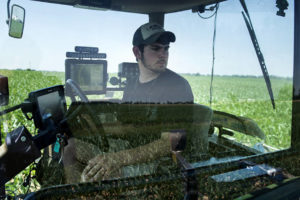
Precision agriculture techniques can save time and potentially improve yields, by targeting and tracking fertilizer application, for example, but the technology is expensive. Brendan Smialowski/AFP/Getty Images
“The problem with precision agriculture is that it’s going to be very expensive and capital intensive, and it’s already a capital-intensive business,” said Mark Rasmussen, director of the Leopold Center for Sustainable Agriculture at Iowa State University.
That, like so many factors influencing today’s agricultural system, favors larger farms.
Simplification Driving Risk
The interaction of a warming climate, crop specialization and concentration “increases the vulnerability of the U.S. food system,” Lengnick warned in a peer-reviewed study published in 2015.
In the agricultural powerhouse of the Midwest, the risks could be especially high because diversity has disappeared across such a broad landscape.
“Most farmers have corn and soy, and if they have a drought they lose everything,” said Francis Thicke, a former soil scientist with the U.S. Department of Agriculture who now keeps a small herd of dairy cows, feeding them grass and hay that he grows on his farm. “There’s very little resilience in these systems.”
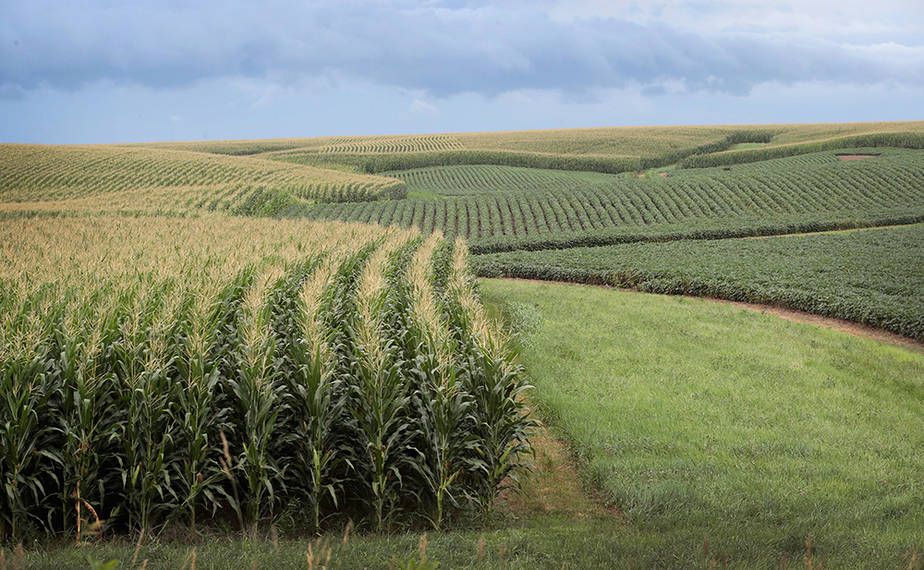
Farms with only one or two crops have less resilience, said Francis Thicke, a former soil scientist with the U.S. Department of Agriculture. “Most farmers have corn and soy, and if they have a drought they lose everything.” Credit: Scott Olson/Getty Images
Diversified farms have more protection against bad weather or low demand. When one crop fails, another provides a back-up. In a simplified farming system, insurance and other government subsidies effectively take the place of this security by guaranteeing payouts when crop yields or prices are low. But most of this federal support goes to larger farms, further driving consolidation.
“You really don’t have to worry if the crop fails because insurance is available and that’s shifted the dynamic,” Liebman said. “Farmers respond to averages, but also to extremes—and insurance buffers the extremes.”
Bigger farms focus on fewer crops because it’s simpler and more efficient, especially on a huge scale. This sacrifices the diversity that keeps the food system safe from the vicissitudes of climate change.
“Redundancy is the enemy of efficiency because redundancy says: Let’s maintain backup systems. Efficiency says: You don’t need them,” Hendrickson said.
Some researchers suggest bigger farms could be less adaptable or able to change course as global warming drives more extreme and unpredictable weather.
“Are these large organization going to be flexible and be able to adjust on the fly, and keep up as things get more erratic and uncertain?” Rasmussen asked. “You may be big and have a lot of influence, buy you can also fall hard.”
A Generational Change
The aging of a generation of farmers is also accelerating consolidation.
The average farmer is approaching 60 years old, and many farmers are relying on the land to finance retirement. But they’re not selling it to young farmers, who can’t afford the high land prices. They’re selling it to larger farms or leasing it out. In Iowa alone, more than half the farmland is farmed by non-owners.
 According to the Oakland Institute, nearly half of all U.S. farmland will change hands in the next 20 years as more farmers retire. “With an estimated $10 billion in capital already looking for access to U.S. farmland, institutional investors openly hope to expand their holdings as this retirement bulge takes place,” the institute says.
According to the Oakland Institute, nearly half of all U.S. farmland will change hands in the next 20 years as more farmers retire. “With an estimated $10 billion in capital already looking for access to U.S. farmland, institutional investors openly hope to expand their holdings as this retirement bulge takes place,” the institute says.
Investors and tenants, critics worry, are less likely to farm in ways that conserve the soil—because conservation measures can shrink profit margins—or to grow diversified crops because there are fewer markets or support for them.
“The traditional midscale family farmers are more likely to be diversified,” Hoefner said. “We used to think in terms of 1,000- or 2,500-acre grain farms being big, and now 10,000- and 15,000-acre farms are not unusual. It’s very hard to imagine those extremely large grain farms diversifying to the extent that we need to solve the problem.”
Last year, U.S. Sen. Cory Booker of New Jersey introduced legislation calling for a temporary moratorium on mergers across the food and farming industries—from seed corporations to grocery stores.
“Consolidation has now reached a point where the top four firms in almost every sector of the food and agriculture economy have acquired abusive levels of market power,” Booker said when he introduced the bill. “As a result, the U.S. is losing farmers at an alarming rate, agricultural jobs and wages are drying up, and rural communities are disappearing.”
But, so far, the momentum continues in one direction.
“They all think bigger is better,” Maxwell said. “Market power gives you political power. Even though many farmers would support better stewardship, we’re beating our head against the wall.”

